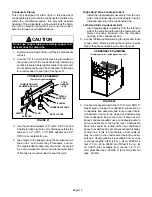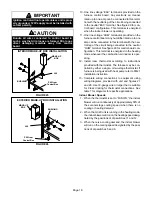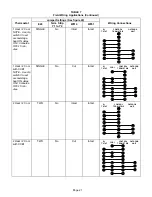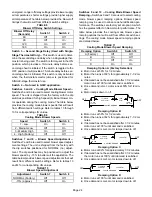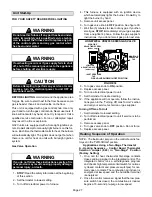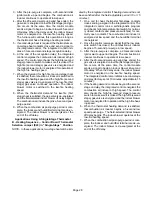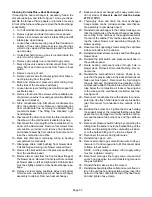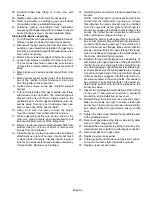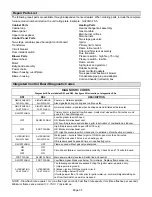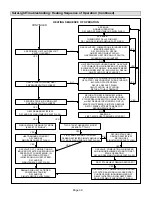
Page 28
3 - After the pre-purge is complete, a 20-second initial
ignitor warm-up period begins. The combustion air
inducer continues to operate at low speed.
4 - After the 20-second warm-up period has ended, the
gas valve is energized on low fire (first stage) and igniĆ
tion occurs. At the same time, the control module
sends a signal to begin an indoor blower 45-second
ON-delay. When the delay ends, the indoor blower
motor is energized on the low-fire heating speed.
The furnace will continue this operation as long as
the thermostat has a first-stage heating demand.
5 - If second-stage heat is required, the thermostat secĆ
ond-stage heat contacts close and send a signal to
the integrated control. The integrated control initiĆ
ates a 30-second second-stage recognition delay.
6 - At the end of the recognition delay, the integrated
control energizes the combustion air inducer at high
speed. The control also checks the high-fire (second
stage) pressure switch to make sure it is closed.The
high fire (second stage) gas valve is energized and
the indoor blower motor is energized for operation at
the high fire heating speed.
7 - When the demand for high fire (second stage) heat
is satisfied, thecombustion air inducer is switched to
the low-fire heating speed and the high-fire (second
stage) gas valve is de-energized. The low-fire (first
stage) gas valve continues operation. The indoor
blower motor is switched to the low-fire heating
speed.
8 - When the thermostat demand for low-fire (first
stage) heat is satisfied, the gas valve is de-energized
and the field-selected indoor blower off delay begins.
The combustion air inducer begins a 5-second post-
purge period.
9 - When the combustion air post-purge period is comĆ
plete, the inducer and humidifier terminal are de-enĆ
ergized. The indoor blower is de-energized at the
end of the off delay.
Applications Using A Single-Stage Thermostat
B - Heating Sequence -- Control Board Thermostat
Selection Jumper (E20) in Single-Stage" Position
NOTE - In these applications, two-stage heat will be initiĆ
ated by the integrated control if heating demand has not
been satisfied after the field adjustable period (10 or 15
minutes).
1 - On a call for heat, thermostat first-stage contacts
close sending a signal to the integrated control. The
integrated control runs a selfĆdiagnostic program
and checks high temperature limit switch for normalĆ
ly closed contacts and pressure switch(es) for norĆ
mally open contacts.The combustion air inducer is
energized at low speed and the humidifier terminal
is energized.
2 - Once the control receives a signal that the low presĆ
sure switch has closed, the combustion air inducer
begins a 15-second pre-purge in low speed.
3 - After the pre-purge is complete, a 20-second initial
ignitor warm-up period begins. The combustion air
inducer continues to operate at low speed.
4 - After the 20-second warm-up period has ended, the
gas valve is energized on low fire (first stage) and igniĆ
tion occurs. At the same time, the control module
sends a signal to begin an indoor blower 45-second
ON-delay. When the delay ends, the indoor blower
motor is energized on the low-fire heating speed.
The integrated control also initiates a second-stage
on delay (factory-set at 10 minutes; adjustable to 15
minutes).
5 - If the heating demand continues beyond the second-
stage on delay, the integrated control energizes the
combustion air inducer at high speed. The control
also checks the high-fire (second stage) pressure
switch to make sure it is closed.The high-fire (second
stage) gas valve is energized and the indoor blower
motor is energized for operation at the high fire heatĆ
ing speed.
6 - When the thermostat heating demand is satisfied,
thecombustion air inducer begins a 5-second low
speed post-purge. The field-selected indoor blower
off delay begins. The indoor blower operates at the
low-fire heating speed.
7 - When the combustion air post-purge period is comĆ
plete, the inducer and humidifier terminal are de-enĆ
ergized. The indoor blower is de-energized at the
end of the off delay.


